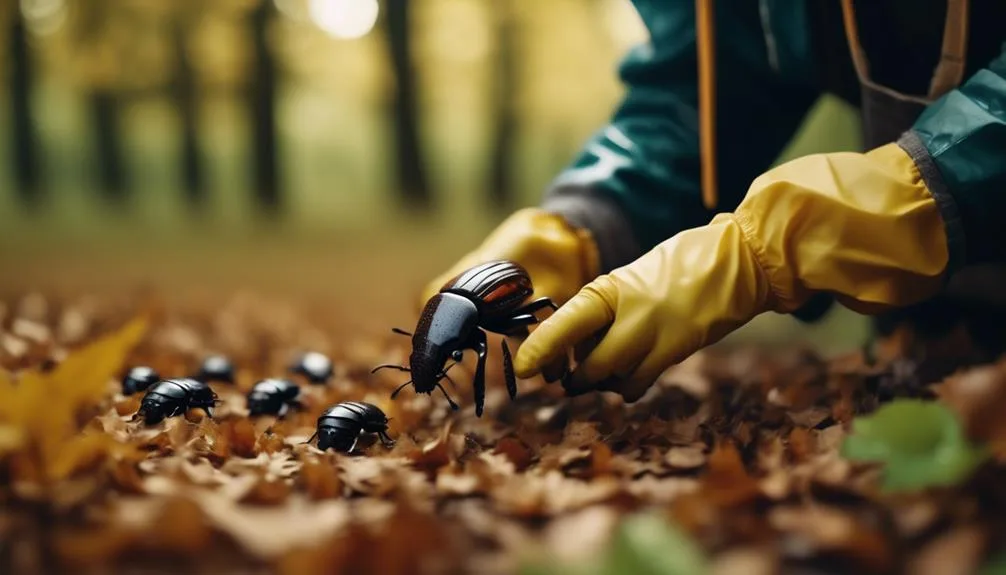Dealing with elm tree leaf beetles can be frustrating. But there are practical strategies to combat these persistent pests and protect your beloved elm trees.
This discussion will equip you with the knowledge and tools to safeguard your trees, from identifying infestation signs to implementing long-term management techniques.
Stick around to learn how to take control and restore your elm trees to their former glory.
Identifying Elm Tree Leaf Beetles
To effectively identify elm tree leaf beetles, closely examine the leaves for small, metallic green or copper-colored beetles with black stripes. These beetles are responsible for causing significant leaf damage, often leaving behind skeletonized leaves, which can weaken the overall health of the tree.
Understanding the beetle's life cycle can aid in effective management. Elm tree beetles typically lay their eggs on the undersides of the leaves, and the larvae feed voraciously, causing the most damage.
It's important to note that these beetles are specific to certain host plants, with elm trees being a primary target. By recognizing the distinct appearance of the elm tree leaf beetle and being aware of the damage they cause, you can take proactive measures to protect your trees from infestations.
Prevention and Monitoring Techniques
Consider implementing a combination of preventive measures and regular monitoring to effectively manage elm tree leaf beetle infestations.
- Integrated Pest Management: Utilize a holistic approach by combining cultural, biological, and chemical control methods to minimize beetle populations.
- Implement proper soil health practices to promote the vitality of your elm tree, making it less susceptible to beetle damage.
- Encourage beneficial insects such as ladybugs and lacewings, which are natural predators of elm tree leaf beetles, to thrive in your garden.
- Regularly monitor your elm trees for early signs of beetle infestations, such as skeletonized leaves, and take prompt action to prevent the spread of the pests.
Natural and Chemical Control Methods
Implementing natural and chemical control methods is essential for effectively managing elm tree leaf beetle infestations and preserving the health of your trees. When dealing with these pests, it's important to consider biological control methods as part of an integrated pest management approach. This involves introducing natural predators or parasites of the elm leaf beetles to help keep their population in check. Additionally, using organic insecticides, such as neem oil application, can be an effective way to control these pests while minimizing harm to beneficial insects and the environment. Below is a table summarizing the natural and chemical control methods for managing elm tree leaf beetles.
| Control Method | Description | Benefits |
|---|---|---|
| Biological Control Methods | Introducing natural predators or parasites of the beetles | Minimizes harm to beneficial insects |
| Organic Insecticides | Using neem oil application | Effective and environmentally friendly |
Cultural and Mechanical Management Practices
When managing elm tree leaf beetle infestations, it's important to incorporate cultural and mechanical management practices to further safeguard the health of your trees and minimize the impact of these pests.
To effectively protect your trees and manage the elm tree leaf beetles, consider the following:
- Tree Protection
- Regularly prune and remove dead or diseased branches to promote tree vigor.
- Utilize physical barriers such as insect netting to prevent adult beetles from laying eggs on the leaves.
- Plant companion plants that deter elm tree leaf beetles, such as garlic or chives, near the base of the tree.
Implementing these cultural and mechanical management practices can significantly contribute to the overall pest management, ensuring the health and vitality of your elm trees.
Long-term Management Strategies
To effectively manage elm tree leaf beetles in the long term, it's crucial to develop a comprehensive strategy that addresses both current infestations and future prevention. Integrated pest management, including biological control methods, is essential for sustainable beetle population control. Implementing biological agents like parasitic wasps can help reduce beetle populations naturally. Additionally, employing pruning techniques to remove and destroy beetle-infested leaves and branches can limit their reproduction. Soil management practices, such as maintaining healthy soil pH and fertility, create an environment less favorable for beetle survival. Here's a useful table to summarize long-term management strategies:
| Management Strategy | Description | Benefits |
|---|---|---|
| Integrated Pest Management | Incorporates various control methods for sustainable pest management | Minimizes environmental impact |
| Biological Control | Introduces natural enemies to regulate beetle populations | Promotes ecological balance |
| Pruning Techniques | Removal of infested plant parts to reduce beetle numbers | Prevents further infestations |
| Soil Management | Maintains healthy soil conditions to deter beetle survival | Creates an inhospitable environment for beetles |
Conclusion
In managing elm tree leaf beetles, a proactive approach encompassing prevention, monitoring, and appropriate control methods is essential for sustaining the health and vitality of your trees.
By identifying the pests, employing cultural and mechanical practices, and resorting to natural or chemical controls when needed, you can effectively mitigate their impact.
This long-term strategy ensures the well-being of your elm trees for years to come, fostering a thriving and resilient environment.

My interest in trees started when I first saw the giant sequoias in Yosemite.
I was a teenager then, and I remember thinking, “I need to learn more about this.”
That moment stuck with me.
A few years later, I went on to study forestry at Michigan Tech.
Since graduating, I’ve worked in a mix of hands-on tree care and community education.
I’ve spent over ten years helping people understand how to plant, maintain, and protect the trees in their neighborhoods.
I don’t see trees as just part of the landscape.
They are living things that make a real difference in our daily lives.
